Lockwood
Custom Optics at the 2013 Winter
Star Party
|
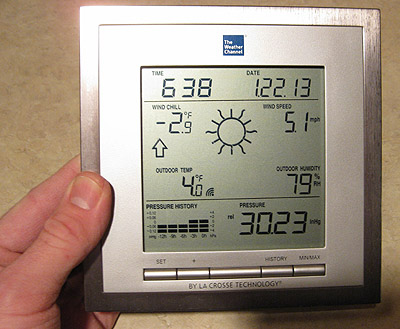 I always seem to work too hard in the winter. The weather is cold and usually gray. The wind blows, unobstructed, across the empty fields and prairie, and there's not much to do outside. I enjoy being outdoors, but not so much in the winter. As a contrast, my shop is warm and bright, and I don't mind putting in some long hours to get my schedule back to somewhere near it should be, and to get some good mirrors out the door. However, when late January or February comes around, I'm definitely ready for a change of scene and climate, and ready to start driving south towards Florida and the Winter Star Party. It's funny how many Floridians do the opposite when their oppressive, hot, virtually underwater summers drive them from their humid tropical peninsula. With a million things to do and remember before I left, I was truly stressed out as my departure approached. One thing I've learned is to give myself more time to prepare for trips, but on this one I did not take my own advice. However, I got everything done, and managed to get to sleep at a reasonable hour to get a decent night's sleep, which I would need. I even managed to not forget anything vital, which was probably a miracle. Above is a snapshot of the weather conditions when I left - it was just plain nasty outside, and I was not sad to put the pedal down. With an early start, my first day's drive got me to southern Georgia at a reasonable hour. A good night's sleep was followed by a nice morning workout on the treadmill to get me going. Awake and refreshed, I walked out the door to see palm trees planted next to the parking lot - this was an improvent over frozen, barren farm fields. I had an easy half-day's drive to get me to the Chiefland Astronomy Village, where I had an appointment to help clean a mirror. Here's the patient, partly undressed. 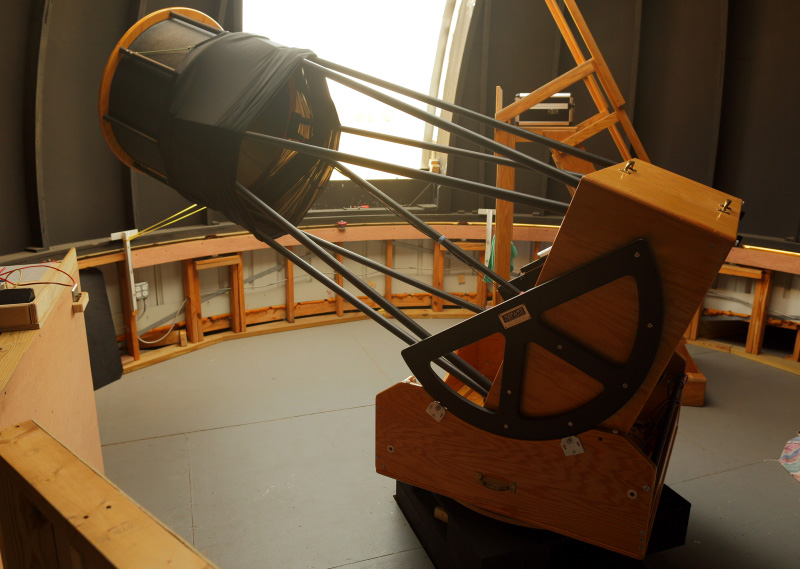 This 28" f/3.5 custom Starmaster FX is owned by Dana and Doris, the nicest Canadians that I know (OK, they all seem to be nice...) and is housed in an elevated dome. They were a bit leary of cleaning the mirror, so I gave them a list of supplies to obtain, suggested a method, and offered to help out. I arrived, and a short time later we got to work cleaning before it got dark (and before we had some good beer). 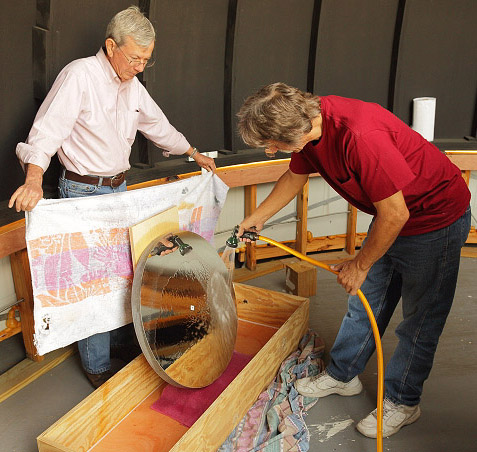 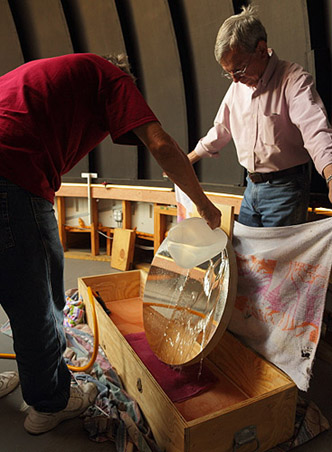 For more mirror-cleaning information, see my article here. (http://www.loptics.com/articles/mirrorcare/mirrorcare.html) Above left, Bud catches any errant spray while Dana sprays water onto the mirror to loosen stuck-on dirt, pollen, and other stuff. Doris supervised off-camera. The box the mirror is sitting in is mostly waterproof and catches the runoff. The observatory is well off the ground, so this method is preferable to bringing the mirror down the stairs. Above right, the mirror is rinsed with distilled water before it can dry, removing any minerals that were in the tap water. The process is repeated several times to remove most dirt that will come loose with this method. 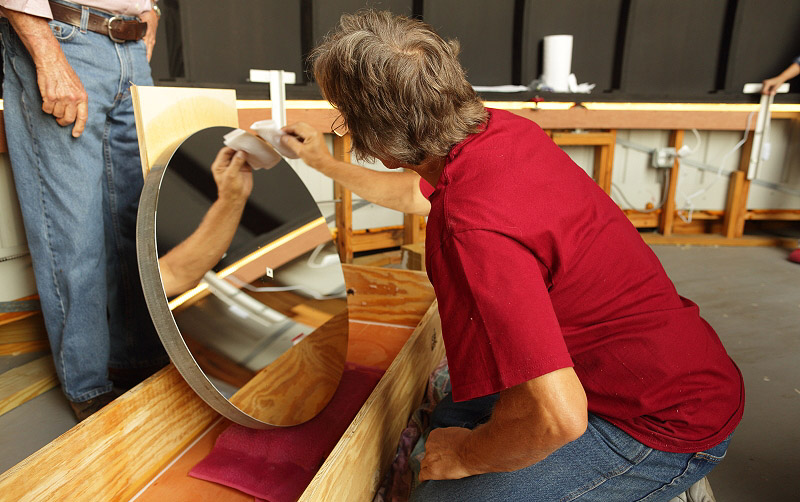 When reasonably clean, the mirror is blotted dry (above) with cotton and other clean cloth. Optionally some solvent can now be used to help remove stubborn spots, since most of the dirt that might scratch the coating has now been removed. We did some of this to remove a residue, and then declared victory. 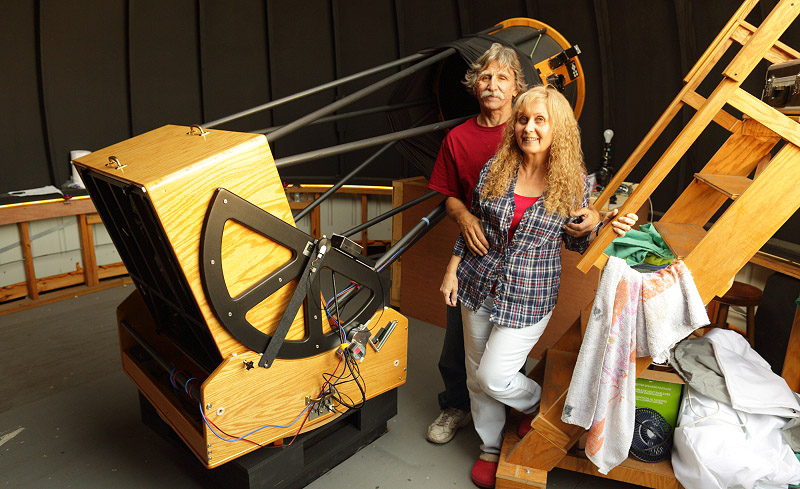 Here the owners pose with their telescope. The platform that the scope sits on helps it see over the base of the dome so that they can look low in the south for those wonderful southern objects that just barely get high enough to view. You might recognize the rolling observing ladder at right - it was Tom Clark's from his dome at Chiefland, but he decided to build a new one for his New Mexico dome/observatory. Dana modified it by shortening it somewhat, and it works beautifully in their dome and with their telescope. |
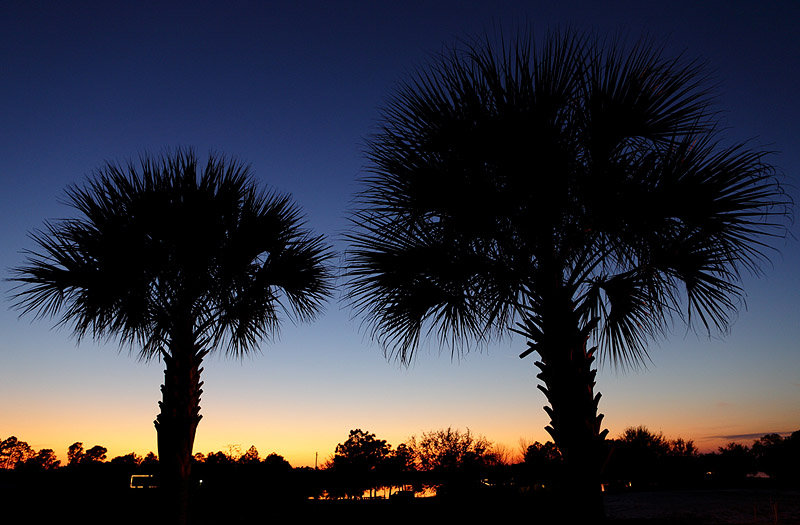 Following my first visit to Chiefland (I would be back later in the trip), I headed to the Orlando area to get some exercise working on my waterskiing skills. I had back problems quite a few years ago, and they persisted while I had a desk job. That contributed to my decision to ditch that job and go full-time making optics. At some point I realized that my back felt really good for several days after skiing, so I decided I should do more of it. So every time I come to Florida during the cold Illinois winter, though most of my trip is business and astronomy related, I always try to spend some time on the water. 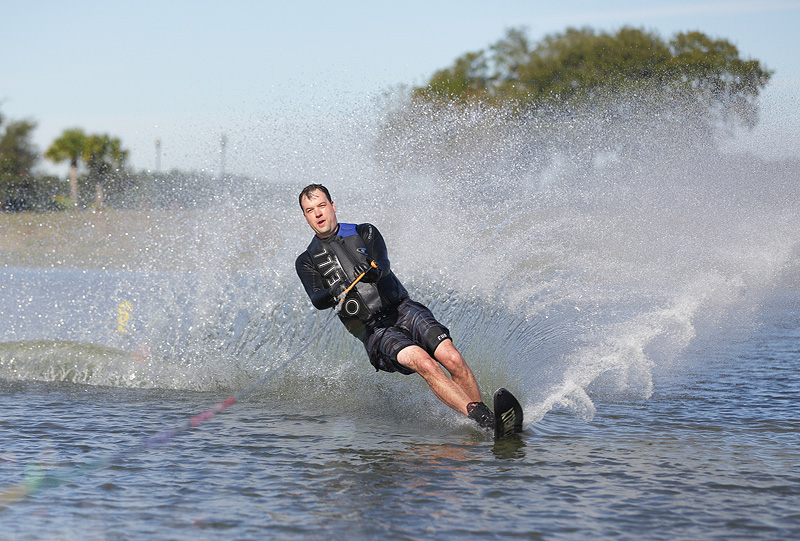 I got a great workout, and didn't seem too rusty despite quite a few months off the water. I also did a bit of running to burn a few more calories and enjoy the sunshine. I'm slowly working up to the slalom course, and my back is stronger and mostly pain-free because of it. As luck would have it, I could do some astronomy-related photography here. The launch of a relay satellite was scheduled for the early evening on one night during my stay. Though I was over 100 miles from the launch pad, I grabbed my camera and tripod and went out between a couple of the lakes and the image below was the result, a nice shot of a ski lake with the rocket arcing into space in the distance. 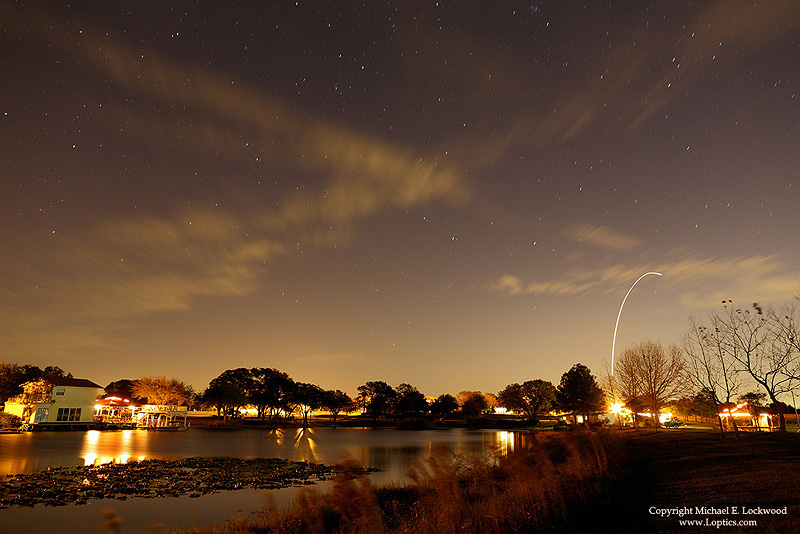 When I was done skiing, I headed a bit farther south to visit some more friends and clients on the way to the Keys, where I met up with John Pratte of JPAstrocraft.com. Then we headed out on the last leg of our journey south. The Keys were actually my fifth stop, and breaking up the trip like this makes it that much nicer and more relaxing. 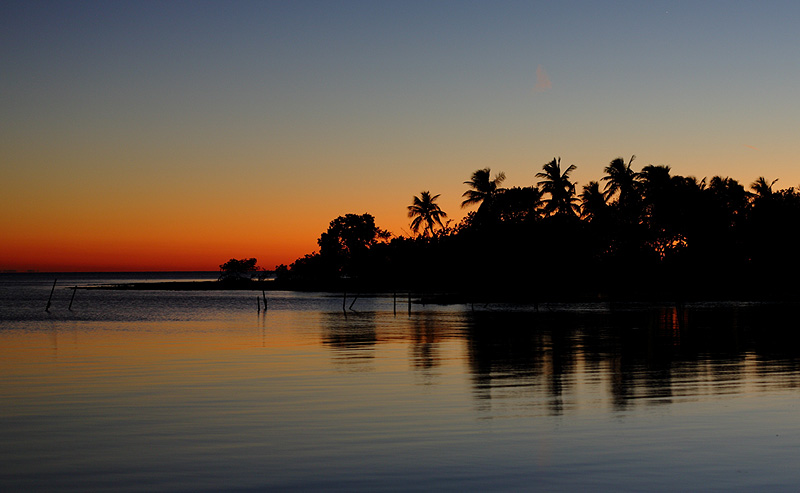 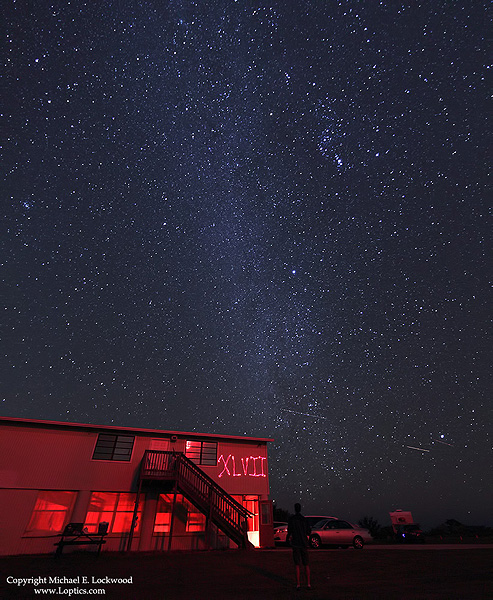 We
were lucky to be invited to join the Winter Star Party staff for their
Super Bowl
party the night before the star party began. Our trip through
the
Keys was faster than most other years because we didn't hit any major
traffic backups on the way, which was a bit of a minor miracle on a
weekend during the winter. By the late afternoon we were at
the
camp
unpacking and setting up. We
were lucky to be invited to join the Winter Star Party staff for their
Super Bowl
party the night before the star party began. Our trip through
the
Keys was faster than most other years because we didn't hit any major
traffic backups on the way, which was a bit of a minor miracle on a
weekend during the winter. By the late afternoon we were at
the
camp
unpacking and setting up.The image above was taken on that evening, while others were enjoying the game. I couldn't resist snapping a few photos as it got dark and the colors came out and shadowed the swaying palm trees. I was outside when the infamous power failure in the stadium helped shift the momentum of the game, but I was not the least bit sad because I was having fun shooting creative photos, like the one at left here. I used a 14mm lens to capture the winter Milky Way and Orion towering above, as well as Orion. Near the horizon a few planes glide to and from tropical destinations. I borrowed a red collimating laser and "wrote" the Super Bowl XLVII roman numerals on the wall of the wheelhouse while the game was being watched inside it. You can see me standing in the foreground, as I carefully aimed the laser and turned it on and off for each letter, trying to stand quite still, and trying to finish before the shutter closed! It took many tries - I had to practice my "handwriting" with the laser until I got it right. Since the star party had not started yet, cars were coming and going and planes were all over the sky, so it was not easy to get the shot and I had to be patient until I finally got an image that I was happy with. The result is shown here. The image below shows the WSP staff enjoying the game on the projection screen that is used for talks. I want to thank the staff for letting us join them, I really enjoyed the game, the company, and the photo opportunities. 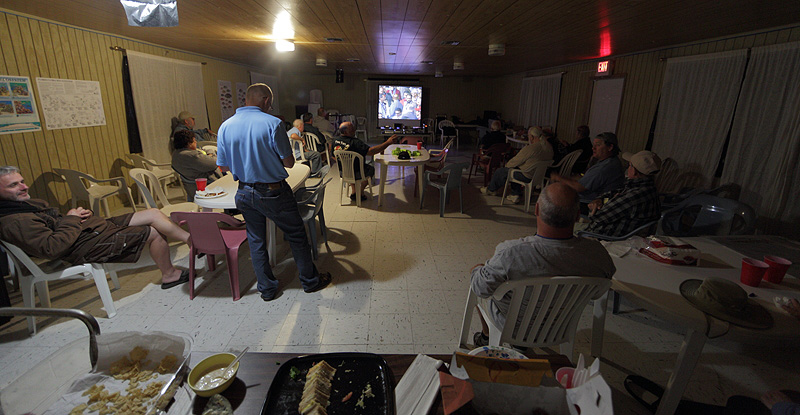 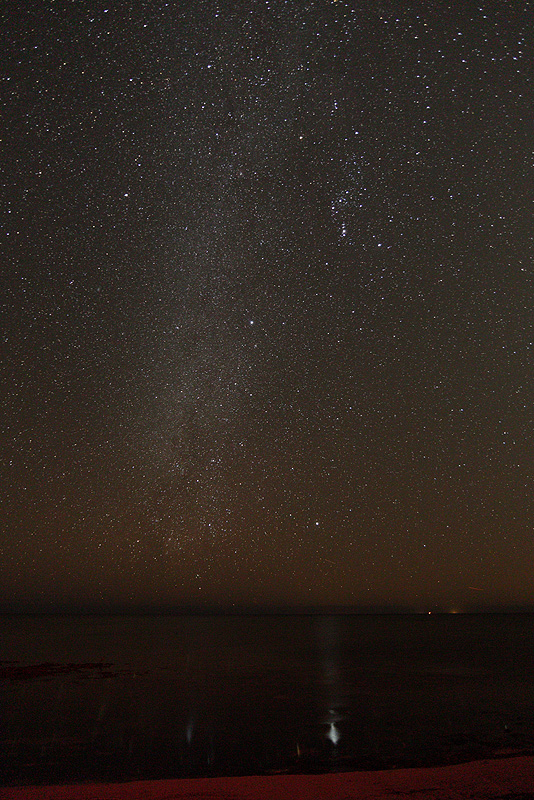 The
wind was coming out of the east on this evening, leaving the shoreline
at the camp mostly sheltered from what was normally a nearly constant
breeze. The
wind was coming out of the east on this evening, leaving the shoreline
at the camp mostly sheltered from what was normally a nearly constant
breeze.As a result, it was possible to record some beautiful shots with the winter Milky Way rising out of the ocean, and the reflections of Canopus and others appearing on the water. I think the small light dome on the horizon may be from Havana. The beach appears red due to the bright red strobe that sits on top of the microwave tower that is across the road from the camp. It paints everything within sight in red light, which is great for night-time photos, but fortunately it doesn't seem to fog the sky for imaging. This is truly a magical place for astronomers and telescopes. I don't understand why people complain about the light pollution at the WSP site. While Big Pine Key and Marathon do have light domes, those domes are confined to the northwest and east, respectively, and the rest of the sky is quite dark. One night, with Dana's sky quality meter (SQM), we watched the readings dip from a good 21.4 to a superb 21.8, approaching 21.9. There is not much "stuff" in the air except water vapor, so the transparency can be quite good. By contrast, air here in the midwest has lots of pollen, dust, and other particulates in it. I find the sky blackness and contrast of objects viewed through a telescope to be absolutely superb here, and I have rarely seen better. I'm certainly trying to find better, but it's not easy! So, if you are not discoraged by a bit of a long drive or humidity, this star party should be on your list - especially if you like good seafood. |
The next day, the star party began, and I watched the field fill up with cars, RVs, tents, telescopes, lawn chairs, piers, tripods, and astronomers. I helped unload Joe's 32" scope from his SUV (below, photo by John Pratte). Every time I do it, I joke about the SUV giving birth. There's not much room to spare, and it's amazing how large of a telescope can come out of a modest-sized vehicle! Not pulling a trailer with the scope in it saves quite a bit of gasoline on the jouney to the Keys. 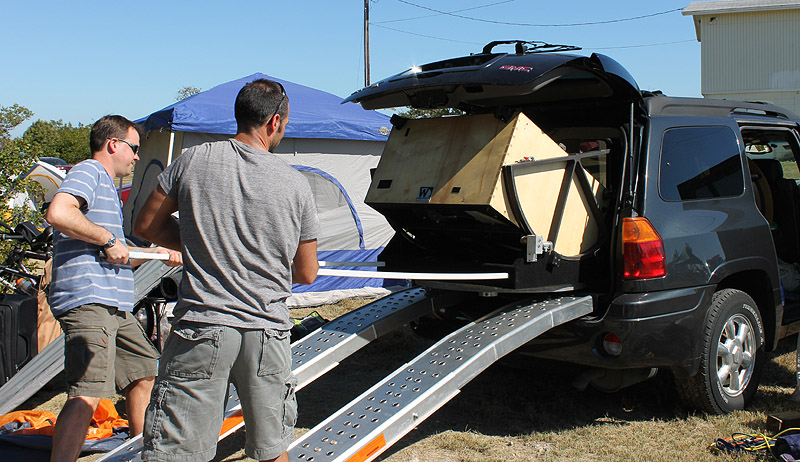 Soon the scopes were set up. In the photo below (photo by John Pratte), Larry stands by the 16" F/4 JPAstrocraft telescope that he would be using for the week. A 25" f/4 JPAstrocraft scope sits in the background, and Joe's 32" f/3.6 is a bit further back. All of these scopes use my optics. John and Joe kindly share their excellent instruments with me at this star party every year, and I really appreciate it. After bringing my 20" f/3 Starmaster-MX for a few years, now I just bring my camera and tripod and look through other people's telescopes. It's much simpler for me, and leaves me freer to wander off into the night when I feel like it without worrying about leaving equipment sitting around or covering it up. I also get to talk to more people and telescope owners. 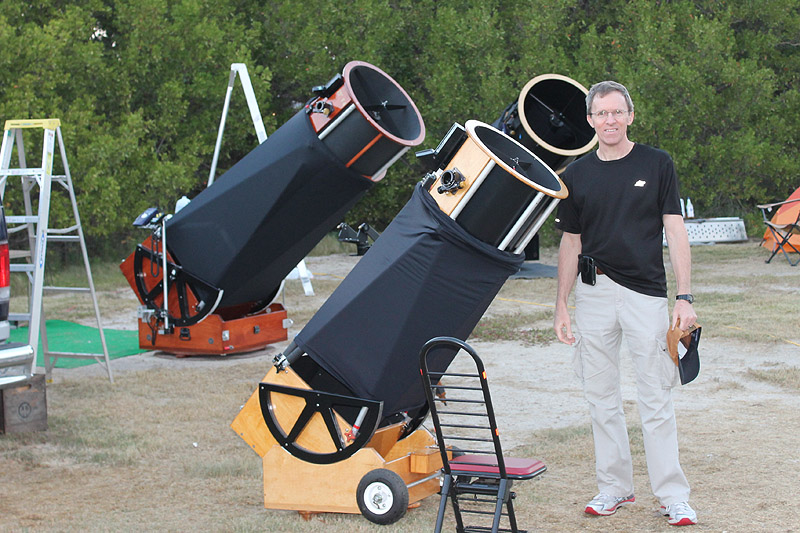 After a seafood dinner in Marathon, the sun sets and darkness comes quickly. Now let's see some night-time images.... 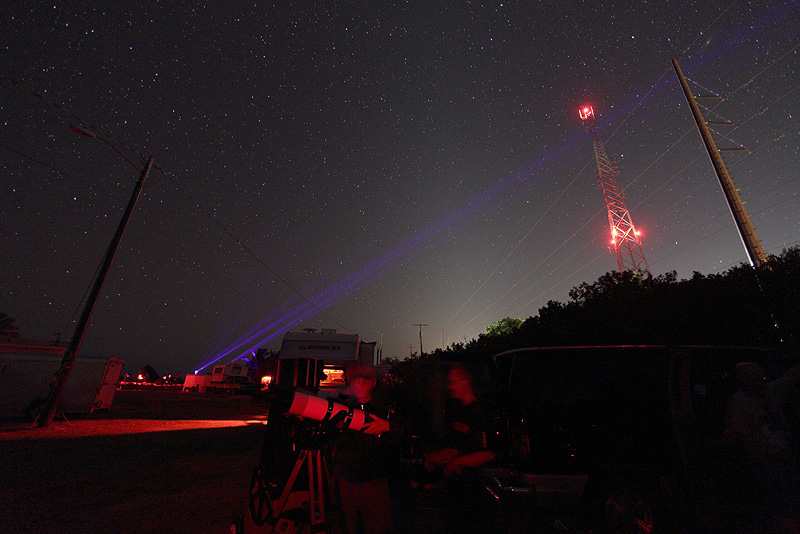 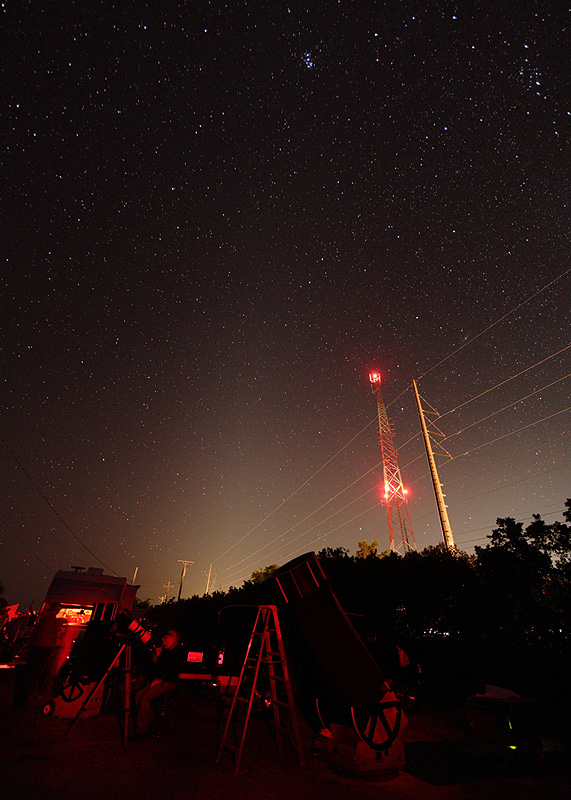 There's
a lot going on in the image above. Let me set the scene. There's
a lot going on in the image above. Let me set the scene.1) A group of observers use a 25" f/4 telescope just out of the frame to the right. 2) The high tension power lines buzz and rattle loudly in the humid night, and the Andromeda Galaxy can just be seen to the right and just above the top of the pole. 3) The microwave tower flashes its bright red strobe to warn helicopters and airplanes. 4) Al Nagler uses his refractor in the bottom center of the frame as a few other people mill around. Al coaxes everyone around to have a look through his scope, usually at some beautiful star cluster in the southern Milky Way. Later in the night, at say 3am when everyone is brain-dead and is covering their scopes, Al will be begging others to turn their large instruments on the masive Omega Centauri so he can get his yearly "Omega Fix", as he calls it. 5) Bob Summerfield's uber-bright blue-purple laser is the only one allowed for pointing out sky objects, and only during his evening talk where he points out the constellations for kids and other newer amateur astronomers. The thing is so powerful, he may use it to trim his beard, too. 6) The Zodiacal light rises straight up from the horizon in the center of the frame. These reflective orbiting particulates are hard to miss. 7) Finally, the lights of passing cars light up the smaller power lines on the left, creating the illusion of a meteor when seen out of the corner of the eye. I coined the term "Power Line-ids" last year, and still call it that. A few others do too! The image at right shows a little different perspective. Al Nagler is still seen using his refractor, but the 25" f/4 is visible too. Further to the right, out of the frame, the 32" f/3.6 gulps photons and the people waiting in line murmur about what object to suggest as the next target. Andromeda is still above and right of the pole, and the Zodiacal light extends a little higher in the sky. Our normal observing spot is near the road, so there is quite a bit of noise from passing cars, motorcycles (often with deafening stereos), tractor trailers, power lines, etc. However, being off the berm, the telescopes are more sheltered from the wind, and this results in better high-power viewing. Sometimes, if it's too loud, I wander up onto the berm to enjoy the sound of palm fronts rattling in the wind, as the occasional telescope drive whirs to life. Life is hard at the WSP. |
Here are a couple of interesting images that I liked. 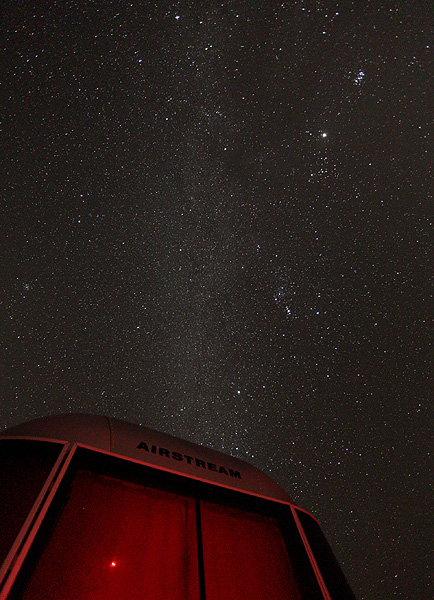 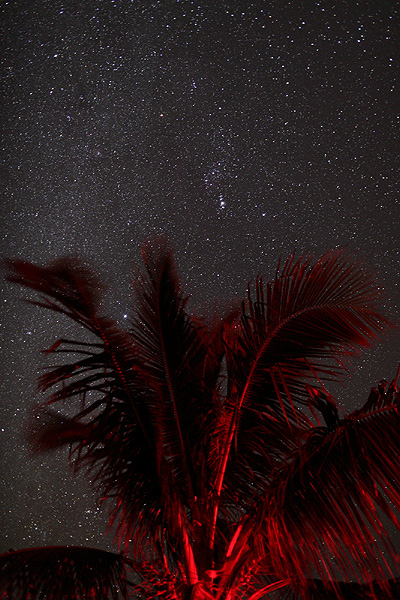 There's just something about the winter Milky Way over a shiny Airstream trailer and Orion over a palm tree that suits my eye. The reflection of the red strobe is seen in the trailer window, and illuminates the palm tree. 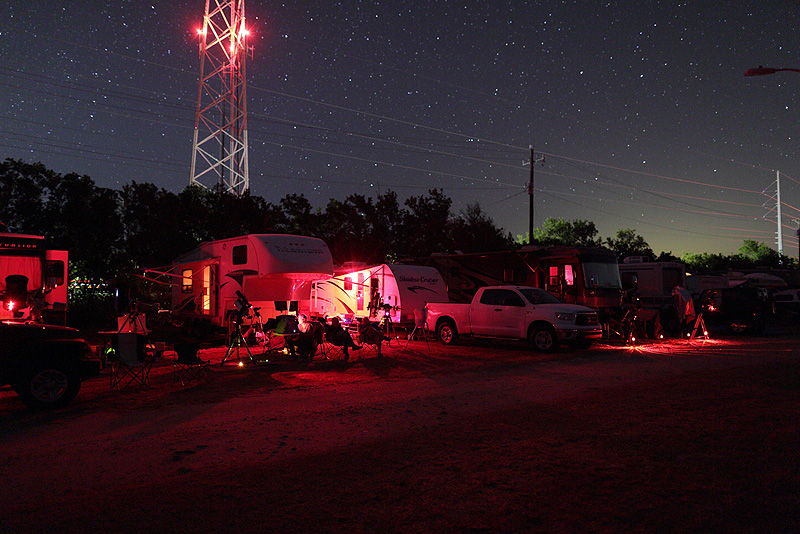 Above, looking northeast from the bottom of the berm, a few attendees sit around relaxing under the tropical skies in front of their RVs, while another scans images on his laptop. It's T-shirt or light jacket weather at worst, as the tropical sea breeze stirs the sea air. If they'd just shut off the computer, phones and internet for a bit, it would be perfect. 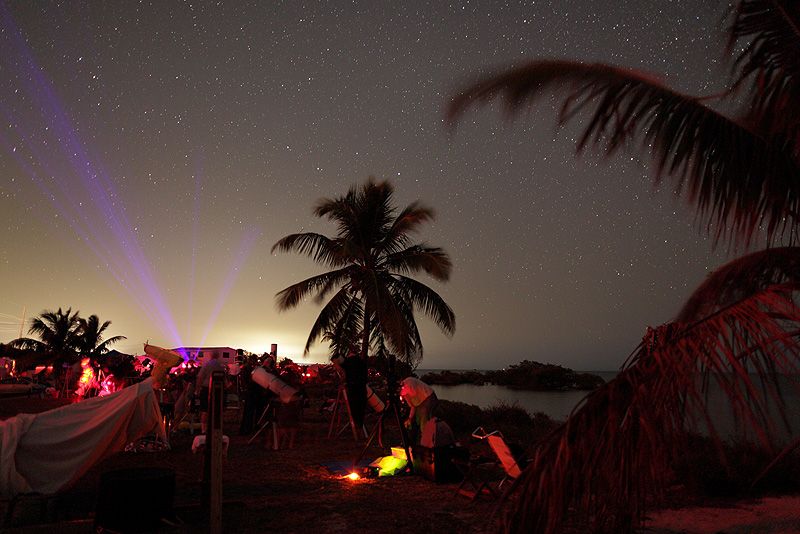 I was up on the berm shooting more photos while Bob continued his sky show. The glow is from Marathon, and appears much brighter than it appears to the eye. You can see just how close to the water it is possible to set up, but beware the wind and salt spray. 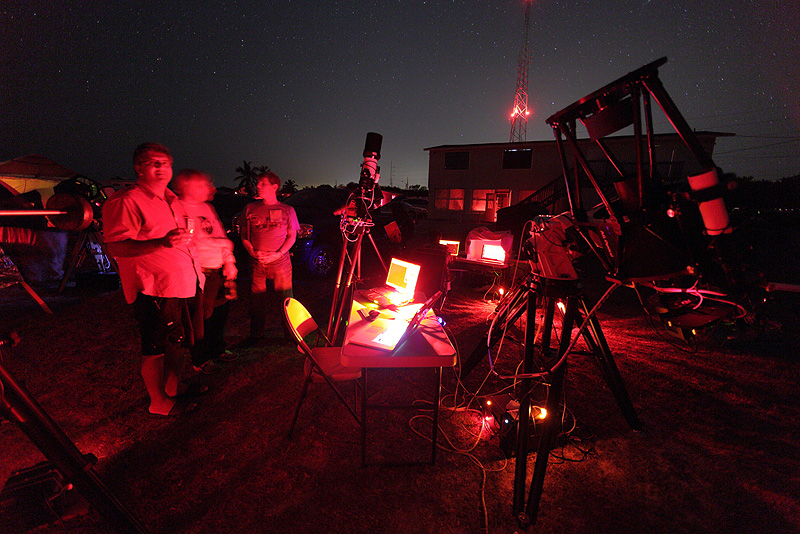 Let's head over to where many of the staff set up - I called it "Imagers Point". It's in the eastern portion of the camp, south of the wheelhouse. Just look for the glow of laptop screens and the smell of cigarettes.... Above at left we see Tim Khan, WSP Director, hanging out while his scope collects photons. Not sure who the person is in the middle, but speaker Richard Crisp is at right. His talk about flat fielding gave me some ideas for my night time and day time images. His web site is narrowbandimaging.com. I want to thank all of the star party organizers for their hard work, for putting on a great event every year, and for inviting me to speak again this year. It's a privilege that I greatly appreciate, and it's always enjoyable to give a talk for an attentive and intelligent audience. 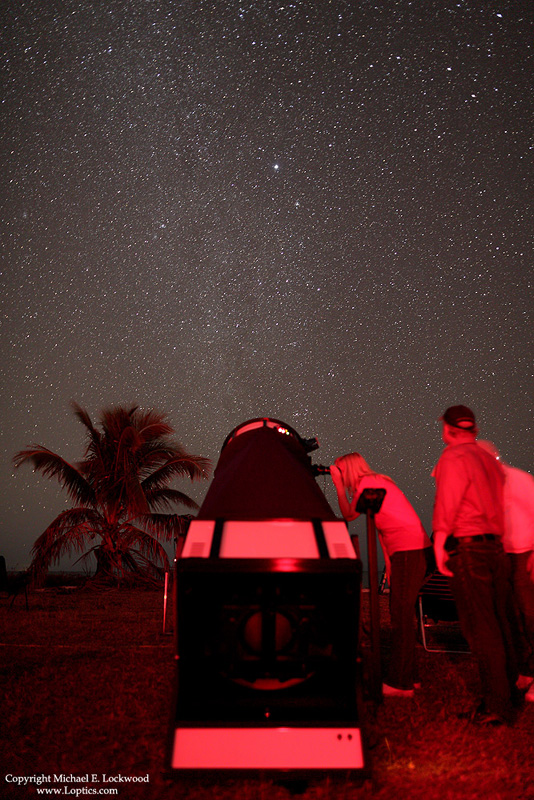
I've taken countless images at the Winter Star Party, but there always seem to be more to capture. The shot at right combines a palm tree, a 22" StarStructure telescope, and Vic and Lynne Menard, observing something in the southern winter Milky Way. The Menards were kind enough to stand still for 20 seconds or so while the shutter was open. I think this shot captures the feel of the WSP fairly nicely - dark skies, palm trees, short sleeves, and big telescopes. Vic liked the image, and asked permission to use it on his web site. I highly recommend his concise book on Newtonian telescope collimation. Observing highlights this year for me personally were Jupiter at high power and M51 high overhead. Jupiter showed a ridiculous amount of detail when the seeing allowed. I thought I saw some detail on one of Jupiter's moons for a few moments on one night, and I wish we had a webcam to capture some frames for later stacking. Viewing M51 high overhead with the 32", the galaxy's dark lanes resolved into textured clumps, which I had never seen before. The sky was quite dark, so the contrast was superb. We again saw ten stars in the Trapezium, though not as easily as in previous years. This is quite seeing-dependent, and is also dependent on how well optics are cooling. Winds were calmer than other years, so mother nature's boundary-layer fan was not working as effectively. Of course, that also meant that the telescopes weren't shaking in strong winds. One night we decided to go power-happy and ended up viewing objects like the Ghost of Jupiter at ridiculously high power. The large aperture provided vivid color to go along with some very nice detail. Al Nagler usually spends quite a bit of time around the 32" and 25", and while on the ladder of the 32" he was overheard to say "I can't believe those tiny little friggin stars!" and "I forgot I was looking through one of my eyepieces!" Al really gets into observing at this event, and I don't know how he gets enough sleep observing late into the night and spending the better part of the day in the TeleVue tent in the vendor area. Somehow he stays enthusiastic well into the night, inviting people to use his refractor, and often bringing people over to look through the larger instruments. In fact, early one morning just as I was about to help Joe cover his 32" scope, Al asked if we could remove the SIPS unit so he could use his binoviewer in the 32" to look at Omega Centauri! Both brain-dead and tired, we didn't want to do the minor telescope surgery that this required, and then reverse it when we were done. Joe and I looked at Al, looked at each other, looked at Al again, and almost in unison, said, as nicely as possible, "No". Instead we all marveled at the cluster with one eye and then shut down the scope for the night. One unique thing about this year's event was the number of clear nights - with the exception of one cloudy evening (after which it cleared), we basically had all clear skies, which was something I had not experienced previously. Usually clouds come and go on many evenings, giving time for a nap or two. Also, as I mentioned above, the winds were not as strong as previous years. Instead of napping during cloudy intervals, we were forced to buy brownies, coffee, and cocoa (or my favorite, coffee with cocoa added instead of sugar, what I call a cheap mocha) frequently from Mickey's Kitchen to keep us going and full of sugar and energy. It was almost like being at Okie-Tex during a good year when there are no clouds. On one evening when the scope did not have a line, Joe and Jim tried their hand at imaging using Joe's 32" f/3.6. Joe used a DSLR in the focuser to image the trapezium in M42. Jim hand-held a cell phone camera up to the eyepiece and imaged Jupiter - it's just one image, no stacking! The images are below, and look really good for first efforts. Needless to say, more detail was visible to the eye than is seen in the images, but they give a hint of what we were seeing. Thanks for sending me the images, guys! 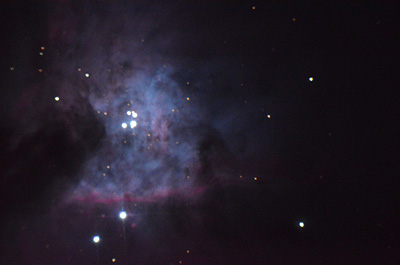 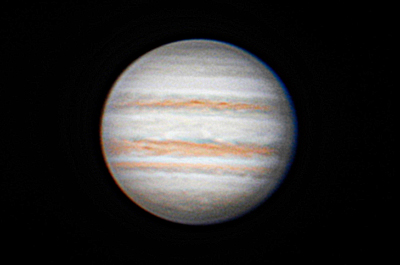 Images
courtesy of Joe Wambo
(left) and Jim Edlin (right)
|
After the star party concluded, I visited relatives and caught up on sleep on the way back to Chiefland where I would stay longer than the previous stop. After a quick stop for a little more skiing on the way, I arrived, but the observing weather was not good, so we decided to have some fun during the day. A number of CAV residents and I headed to Swamp Head Brewery in Gainsville one afternoon and sampled their brews, which were quite good. Some of the damage is shown below. 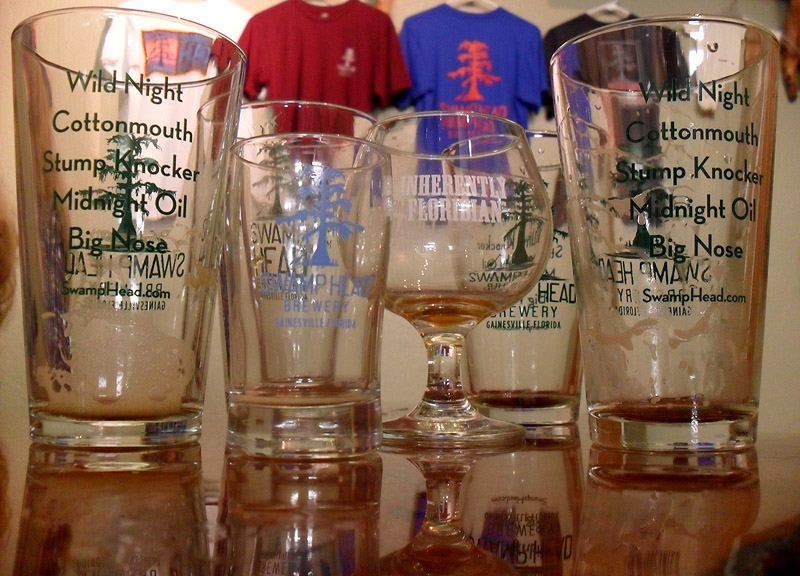 When it's cloudy, enjoying a tasty beverage, preferably one that I can't see through, is one of my favorite ways to take my mind off poor observing weather. Such beverages have helped motivate many a telescope idea in the past. 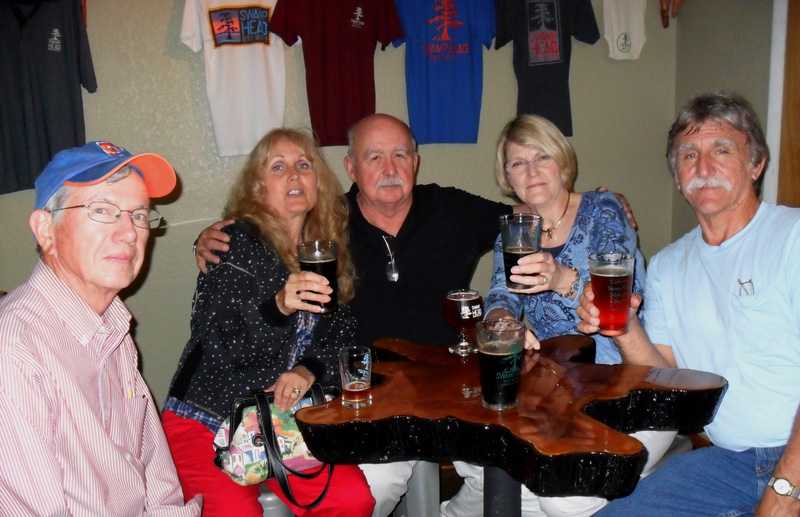 Here's the Chiefland crew enjoying some nice dark beer. Refueled, I relaxed for a few more days in the semi-warm weather before heading back to the frozen north. Clear, dark skies, warm weather, good friends, good seeing, and cheers. -Mike Lockwood, Lockwood Custom Optics |